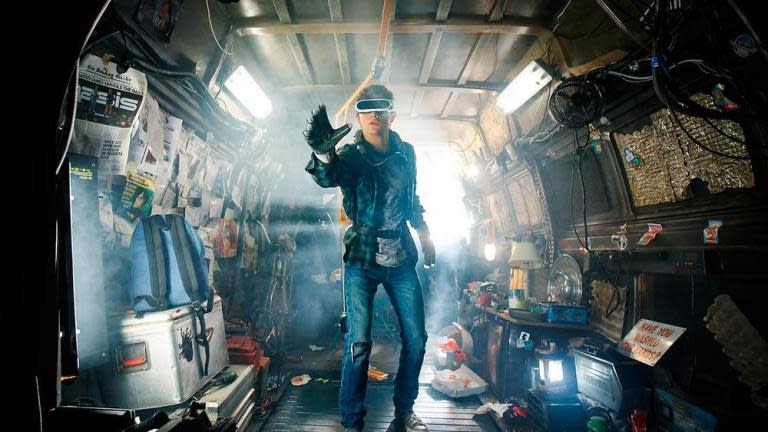Ready Player One review: Spielberg’s dystopia is a nerd’s delight but this is a kids’ movie that pulls its punches
Steven Spielberg’s Ready Player One (which received its European premiere in London on Monday night) is a nerd’s delight. It is a sci-fi film crammed so full of pop culture references that it could easily have risked sagging under the weight of its own nostalgia. The nods to 70s and 80s music and films are never ending. Tasters of everything from Atari video games to Stanley Kubrick’s The Shining, from John Hughes bratpack movies to Saturday Night Fever, from John Boorman’s Excalibur to King Kong, are thrown into the mix. Instead of the usual rousing John Williams score, we are treated to a jukebox-like selection of songs from Van Halen, New Order and Tears for Fears among many others. Younger cinemagoers, at whom the film is surely aimed, are likely to be a little perplexed by all the nods to Back to the Future, Alien and Silent Running and arcane discussions of 80s teen flicks like Fast Times at Ridgemont High.
The intentions behind the film aren’t clear. Depending on which scenes you are watching, this is either a celebration of the mind-bending possibilities of Virtual Reality or a dark and despairing satire about the addictive nature of computer gaming and how far it takes players away from proper human interaction.
Spielberg is far too accomplished a storyteller to allow the in-jokes to slow down the narrative, which moves along at a ferocious tempo. This is an adaptation of Ernest Cline’s 2011 novel. The director is touching on some of the same themes he explored in his 2001 feature A.I.: Artificial Intelligence. “These days, reality is a bummer, “we are told as the film opens in a grim and dystopian-looking Columbus, Ohio, in the mid
2040s. The US has gone through drought and the “bandwidth riots.” Citizens are living in ramshackle, slum-like conditions but they can all still seemingly afford to play “OASIS,” the ultimate VR computer game.
Once they put on their headsets, they can change gender and appearance. The game was designed by James Haillday (played in delightful fashion by Mark Rylance), a very dweebish visionary who died some years before. (We see him in flashback. He’s a benign and oddball figure, part Merlin, part Steve Jobs.)
Halliday has set players a challenge. There are three magic keys lurking somewhere within the universe of OASIS. Whoever can discover them and then track down the hidden Easter Egg will inherit his fortune. Unhappy youngster Wade Watts (Tye Sheridan) is one of the most enthusiastic “gunters,” as the players are called. When he puts on his headset, he forgets his everyday life in the trailer park and assumes a new identity as a fearless young dude called Parzival. He’s a brilliant player but hasn’t come anywhere near finding even the first clue. Nor have all the professional players hired by the shadowy villain, Sorrento (Ben Mendelsohn), the boss of the world’s second best games company, IOI, who is hatching a fiendish plan to take “control of the future.” Rebels are fighting to keep the egg away from him. Parzival is very drawn to the glamorous young punk and motorcycle girl, Art3mis (Olivia Cooke) who plays the game even harder than he does.
Spielberg cuts between dull, muddy “reality” and the hyper-charged world of the VR game. It’s as if we are watching a live action and a computer animated film at the very same time. Some of the special effects are astounding. Early on, we are treated to whacky races, demolition derby style chase across the highways of OASIS. Players aren’t just competing against one another – they have dinosaurs and King Kong waiting to ambush them. Even better is a later scene in which the main protagonists (or their “avatars”) end up in the Overlook Hotel from The Shining. One character has never read the book or seen the movie and so doesn’t realise just how much blood is likely to flow out of the lifts.
As viewers, we are not able to play the game ourselves. (This is the kind of project that would surely have worked better if it had an interactive element.) The attempts at combining ironic nostalgia and action-adventure don’t always work. Mendelsohn makes an enjoyably sleazy and unpleasant villain but this is a kids’ adventure and the filmmakers pull their punches whenever the storytelling risks becoming too disturbing.
Released only a couple of months after his weighty political drama The Post, Ready Player One reminds us yet again of Spielberg’s extraordinary versatility. It is made with his customary fluency and shows an offbeat humour you wouldn’t normally associate with him. No other mainstream director has tackled Virtual Reality in as inventive a way as he does here. Even so, this still feels like a relatively minor work in the Spielberg canon - a kids’ movie let down by its own very knowing and adult sensibility.



